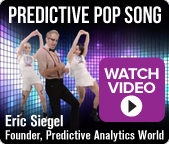Conference Day 1: Monday, October 30, 2017 |
Located in Hall 1E
Exhibit Hall Hours:
Monday 8:00am-7:00pm and Tuesday 8:00am- 3:30pm
Registration
8:00-8:45am • Room: Exhibit Hall
Networking over Coffee
Conference Chair Welcome Remarks
KEYNOTE
The Right Analytics for the Job: Tips and Tricks for Success
Welcome to the Analytics Explosion! Despite speculation that the need for analytics would begin to level-off, evidence suggests it continues to be at an all-time high. Trends show the establishment of more and more in-house analytics teams, allowing the luxury of predictive and prescriptive analytics to be applied across all levels of an organization. However, many factors should be considered when evaluating an analytics undertaking, such as complexity of the problem, precision necessary in the solution, and timeliness required for the response. With so many variables, how do you choose the right analytics tool for the job? What else is required for an analytics effort to be successful? Leveraging a dynamic analytical approach will achieve the greatest value for your business.
 9:40-10:00am • Room: 1E09/1E10
9:40-10:00am • Room: 1E09/1E10
Diamond Sponsor Presentation
Machine Learning Automation: Large Scale Adoption of Predictive Analytics
In the 21st century, organization's ability to turn their data into decision and intelligence differentiate it from the competition. This process has three components: 1) Ability to develop and refresh 100s of predictive models; 2) Deploy them in the existing tech infrastructure, and 3) Operationalize them - i.e. integrate them in the day-to-day decision making. In this short presentation, we will discuss how artificial intelligence allows us to build machine learning automation that helps organizations meet these goals and drive a large scale adoption of machine learning and data-driven decisions.
10:00-10:30am • Room: Exhibit Hall
Exhibits & Morning Coffee Break
 Book Signing with Eric Siegel, author of The Power to Predict who Will Click, Buy, Lie, Or Die
Book Signing with Eric Siegel, author of The Power to Predict who Will Click, Buy, Lie, Or Die
[ Top of this page ] [ Agenda overview ]
 TRACK 1 - Crisis response; analytics management
TRACK 1 - Crisis response; analytics managementLessons from: NYC Mayor's Office
Quickly Building an Analytics Environment to Address a Public Health Crisis in NYC
Predictive analytics has proven to be a highly useful tool in the public sector, but what happens when an emergency strikes and we have to build an entire analytics infrastructure from scratch? In this case study, the NYC Mayor's Office of Data Analytics (MODA) will walk you through how the City of New York built a system to collect, monitor, and predict the presence of potentially disease-carrying cooling towers (Legionnaires' Disease) among New York's one-million plus buildings in less than a week.
10:30-11:15am • Room: 1E09/1E10
 TRACK 2 - Hand-labeled training data
TRACK 2 - Hand-labeled training dataCase Study: Bloomberg L.P.
Crowd-Sourcing and Quality:
How To Get The Best Out of Hand-Tagged Training Data for Machine Learning Models
Machine learning models depend on often large amounts of training data for supervised learning tasks. This data may be expensive to collect, especially if it requires human labeling (as in for document or image classification) and raises some particular quality issues. For example, how do we ensure that human agreement is high and what do we do in the event that it is not? Also, when your data is expensive to tag, how do you ensure that you have the smallest set possible that is representative of all your features? This talk will address these and other issues associated with gathering crowd-sourced, hand-coded data sets for supervised machine learning models.
[ Top of this page ] [ Agenda overview ]
 TRACK 3 - Churn modeling
TRACK 3 - Churn modeling
Retention Modeling in Uncertain Economic Times
Small businesses are susceptible to even minor changes in economic conditions. When strategically allocating retention efforts across half a million businesses, we need to account for said changes as well as maximize our resource allocations. Traditional modeling techniques can fail over time in the presence of concept drift. We devised an innovative method to account for unknown changes by using seasonal model and trend model to probabilistically assign retention efforts. Additionally we built in functionally that allows new variables to be considered for development as they become relevant. This new methodology removes the necessity for annual retools and stabilizes performance.
[ Top of this page ] [ Agenda overview ]
 TRACK 1 - Education and team building
TRACK 1 - Education and team building
Lessons from: LinkedIn
The Sprint for Teaching Data Science: LinkedIn Learning, Analytics, and the New Era of Just-In-Time Skills Training
LinkedIn Learning's mission includes training the enormous number of people who need data science and business analytics skills. But what's the best way to assess market demand and develop tools for validation in stack-ranking skills coverage? How do you go from a handful of data science courses to over 100 in less than a year, and make them as effective as possible? How do you find the best instructors? How and why do we contrast with standard classroom education and with alternative learning like MOOCs? LinkedIn, a data company, uses analytics to answer these questions and to guide our strategy.
11:20am-12:05pm • Room: 1E09/1E10
 TRACK 2 - Time series modeling
TRACK 2 - Time series modeling
Time Series Prediction with Twitter: A Case Study of Crime in New York City
The problem of predicting, for each type of crime, the crime frequency in a specific area on a specific day can be framed as a regression problem on crime frequencies and Twitter data: given (1) the last 31 days of Twitter activity geo-tagged in the immediate area, (2) the last 31 days of Twitter activity in the general area, and (3) the historical crime frequencies of the general area for the past year, predict the crime frequency for the next day in that location. Inherent in this problem description is the following prediction: the taxonomy used in tweets from around the area (such as a large fraction of restaurants with low ratings, or lots of tweets about how unsafe people feel in that area) contains information that could be used to build predictors of future crime frequencies for different types of crime. Assuming that the time series can be modeled as deviation from a periodic function, and incorporating this assumption into the model, may potentially produce better crime frequency estimates than directly predicting crime frequencies. The proposed research has implications for decision makers concerned with geographic spaces occupied by Twitter users. This session will cover these analytical results, which were produced by an extended group of graduate students and researchers at New York University.
 Aaron McKinstry
Aaron McKinstryComputer Scientist
Courant Institute of Mathematical Sciences of New York University
 TRACK 3 - Churn modeling
TRACK 3 - Churn modeling
Case Study: Atlassian
Predicting Customer Churn from Product Usage at Atlassian
Measuring customer churn is a key aspect of marketing data science regardless of the type of product a company is selling. In fact, identifying the most predictive features is equally important as identifying the users at risk of churning because it can help marketing and sales teams alike in adopting the most appropriate strategy to retain their customers, improve their product and identify new opportunities. This presentation will present a decision tree-based methodology to compute churn likelihood, and will discuss which attributes, behavioral features or character traits, are the most beneficial to our model.
[ Top of this page ] [ Agenda overview ]
 TRACK 3 - Market research and analytics
TRACK 3 - Market research and analytics
Case Study: Verizon Wireless
Predicting Brand Love With Wireless Behaviors
Using robust data anonymization, safeguarding, and security, Verizon linked thousands of brand health survey participants to their actual customer database records to see how behaviors like increased data usage or phone upgrades could predict changes in surveyed ratings of the brand. This presentation will discuss the business value of analytics around the brand then delve into the analytic methods and selected results.
12:05-1:30pm • Room: Exhibit Hall
Lunch
 12:25-1:15pm • Room: 1E09/1E10
12:25-1:15pm • Room: 1E09/1E10
Lunch & Learn
How to start on Machine Learning and Predictive Analytics
Machine Learning is the core capability of any modern financial institute. Every data user needs to have an ability to use available data and build predictive analytics models to drive their decision making or lead a data science team. During this session, we will discuss the critical building blocks of predictive analytics and machine learning, will show you an end to end process of "data to decision", and finally will share a road map for you on how to develop machine learning capability for yourself and for your organization.
1:30pm-2:15pm • Room: 1E09/1E10
KEYNOTE
The Predictability Predicament: Your Model Overlooks the Real Target
In the context of building predictive models, predictability is usually considered a blessing. After all - that is the goal... to build the model that has the highest predictive performance. The rise of 'big data' has, in fact, vastly improved our ability to predict human behavior, thanks to the introduction of much more informative features.
However, in practice, the target variable is often more differentiated than accounted for in the data. For example, some customers churn (from a telecom provider) because they are moving, others because they got a better offer in the mail, and the third because their home is in a location with terrible reception. These are all positives for a model that learns to predict churn, but the predicted outcome has occurred for very different reasons. In many applications, such mixed scenarios mean the model will automatically gravitate to the one that is easiest to predict at the expense of the others. This even holds if the predictable scenario is by far less common or relevant. In the worst case, predictive models can introduce biases NOT even present in the training data.
In this talk, we will cover a number of applications where this takes place: clicks on ads being performed 'intentionally' vs. 'accidentally', consumers visiting store locations vs. their phones pretending to be there, and finally customers filling out online forms vs. bots defrauding the advertising industry. In conclusion, the combination of different and highly informative features can have a significantly negative impact on the usefulness and ethics of predictive modeling.
[ Top of this page ] [ Agenda overview ]
Diamond Sponsor Presentation
Opportunity - Driven Enterprise: Turning Business On Its Head
diwo is an unparalleled cognitive decision-making platform developed by Loven Systems that uncovers businesses opportunities in real-time and empowers users to act on business situations before they occur. diwo analyzes multiple sources of data using specialized analytic models to provide you with contextual, timely insights. By guiding users through business decisions, diwo ushers in a new era of opportunity-driven enterprise.
 TRACK 1 - Analytics strategy
TRACK 1 - Analytics strategy
Lessons from: The Clorox Company
Getting Started with Data Science Driven Insights, Execution and Innovation in the CPG Industry?
The need to be more consumer (data) centric, availability of disparate sources of granular data and rapidly advancing technology, techniques and skills makes it necessary and feasible for consumer packaged goods (CPG) companies to embed data science into their analytics strategy to further drive growth and innovation. In this session, we will discuss factors that make Data Science (in CPG) difficult, the organizational maturity curve of CPG analytics, data and techniques that can be used for driving the consumer journey, some techniques and use cases to get started, some in-house examples at Clorox and some key learnings in the journey so far.
 TRACK 2 - Analytic methods
TRACK 2 - Analytic methods
Machine Learning vs. Feature Engineering: What should the Focus be in Attempting to Predict Customer Behaviour
The use of machine learning is a common theme in organizations today, yet most people still struggle with its definition given its many different levels. In this session, we attempt to eliminate this confusion by exploring a number of machine learning algorithms ranging from the simple to the more complex. We observe the use of these algorithms across a variety of industries as well as different behaviours such as customer response and customer risk. Alongside the comparison of machine learning algorithms, we also look at the impact of the data and how feature engineering impacts a given solution.
 TRACK 3 - Acquisition for academic enrollment
TRACK 3 - Acquisition for academic enrollment
Case Study: Becker College
Acquisition Funnel for Higher Education
Predictive modeling has gained popularity in studying college enrollment due to fierce competition in higher education. To make informed decisions and allocate limited resources to improve enrollment, predictive modeling has been applied to challenge and change the traditional recruitment process. This session is intended for two learning outcomes: Participants who are not familiar with predictive modeling will learn how to lay out a plan to collect and build acomprehensive data infrastructure and conduct predictive modeling. Participants who have run predictive modeling will learn how to critically examine the quality of their predictive analyses.
 Feyzi Bagirov
Feyzi Bagirov
Data Science Advisor at Metadata.io and Analytics Instructor, Harrisburg University of Science and Technology
Becker College
 TRACK 3 - Uplift Modeling
TRACK 3 - Uplift Modeling
Case Study: Telenor; US Bank
Uplift Modeling: Optimize for Influence and Persuade by the Numbers
Data driven decisions are meant to maximize impact - right? Well, the only way to optimize influence is to predict it. The analytical method to do this is called uplift modeling (aka, persuasion modeling). This is a completely different animal from standard predictive models, which predict customer behavior. Instead, uplift models predict the influence on an individual's behavior gained by choosing one treatment over another. In this encore session, PAW founder Eric Siegel provides an introduction to the growing field of uplift modeling.
[ Top of this page ] [ Agenda overview ]
3:25-3:55pm • Room: Exhibit Hall
Exhibits & Afternoon Coffee Break
 TRACK 1 - Analytics strategy
TRACK 1 - Analytics strategyLessons from: Prudential Financial Inc.
Value Creation Through Analytics Innovation
Data analytics has been one of the hottest areas that companies invested in their future, hoping to keep up and improve competitive standing in the industry. Yet many executives at the C level have doubts on its return and the value that these investments will bring. In this talk, first we will review the challenges that companies faced in planning and working on analytics projects. Then we will examine various types of analytics innovations, and different value outcomes these innovations may bring.
 TRACK 2 - Analytical methods
TRACK 2 - Analytical methods
Case Study: Citigroup
A Modified Logistic Regression Approach Enhanced by New Interactions and Scaling Detections through Random Forests and GBM
The model variable selection process is a key component of predictive analytics. Whereas logistic regression depends on feature selection/discovery being done beforehand, Random Forests and GBM tree based machine learning approaches intrinsically enact feature selections. However, default options for Random Forest and GBM are biased towards continuous variables, less favorable for categorical and binary variables. Unbiased solutions are very computational intensive. We propose a new approach that combines the strengths of intrinsic feature selection from Random Forests and GBM to detect non-linear relationships, enact scaling, and find interactions, and integrate these non-linear transformations into a traditional approach. A 7-10% lift is observed.
[ Top of this page ] [ Agenda overview ]
 TRACK 3 - Churn modeling; uplift modeling
TRACK 3 - Churn modeling; uplift modeling
Case Study: The Co-operators
Which Predictive Model Will Best Help Increase Retention?
A wide variety of models exist for predicting customer retention, each with different data requirements and model outputs. These diverse modeling options make it difficult to identify the approach with the highest potential predictive power for increasing retention. This case study explains how a survival analysis approach to predicting household retention was replaced by a more complicated but more precise "true-lift" model. This model was used for targeted marketing campaigns undertaken to increase household retention for a Canadian insurer, with performance monitored over one year. The "true-lift" model performed better than the retention model.
[ Top of this page ] [ Agenda overview ]
 TRACK 1 - Building Data Science Teams
TRACK 1 - Building Data Science Teams
Lessons from: Comcast
Accelerating Data Science Innovation
As more and more companies strive to recruit and build data science teams, they must also identify how to structure those teams within the organization to drive innovative data science applications that will propel their business. This session will cover key considerations in structuring a data science organization capable of generating the big analytical ideas that will have the biggest impact on pushing the business forward.
 TRACK 2 - Forecasting; analytical methods
TRACK 2 - Forecasting; analytical methods
Case Study: Micron Technology Inc.
Demand Forecasting with Machine Learning
Accurate forecasting of customer demand for products is critical to success in the semiconductor industry. A diverse product portfolio, detailed customer mappings, dynamic market conditions, and extended production cycle times all sharpen the need for a reliable and responsive automated forecasting solution. I will describe a custom forecasting model recently developed by and now in use at Micron Technology Inc. that combines machine learning algorithms, established time series modeling techniques, and human expertise in leveraging existing forecasting infrastructure to achieve significant improvements in forecast accuracy across multiple levels of the product and customer hierarchy.
 TRACK 3 - Optimizing outreach; uplift modeling
Using Rapid Experiments and Uplift Modeling to Optimize Outreach at Scale
TRACK 3 - Optimizing outreach; uplift modeling
Using Rapid Experiments and Uplift Modeling to Optimize Outreach at Scale
In the current environment, media consumption is fragmenting, cord cutters are an increasingly large segment of the population, and "digital" is no longer a ubiquitous, single medium. As such, large companies and other organizations looking to do outreach at scale to change individuals' behavior have an overwhelming number of choices for how to deploy their outreach resources. In this talk, Daniel Porter, co-founder and Chief Analytics Officer of BlueLabs, will discuss how current tools which combine uplift models with state of the art allocation algorithms make it possible for organizations ranging from Fortune 100 companies to Presidential Campaigns to large government agencies to optimize these decisions at the individual level, leading to ensuring delivery of the right message to the right person at the right time, through media channels where an individual is most likely to engage positively with the content.
5:30-7:00pm • Room: Exhibit Hall
Networking Reception
Dinner with Strangers
[ Top of this page ] [ Agenda overview ]
Conference Day 2: Tuesday, October 31, 2017 |
Located in Hall 1E
Exhibit Hall Hours:
Monday 8:00am-7:00pm and Tuesday 8:00am- 3:30pm
Registration
8:00-8:35am • Room: Exhibit Hall
Networking over Coffee
Conference Chair Welcome
Special Plenary Session
What to Optimize? The Heart of Every Analytics Problem
Every analytics challenge reduces, at its technical core, to optimizing a metric. Product recommendation engines push items to maximize a customer's purchases; fraud detection algorithms flag transactions to minimize losses; and so forth. As modeling and classification (optimization) algorithms improve over time, one could imagine obtaining a solution merely by defining the guiding metric. But are our tools that good? More importantly, are we aiming them in the right direction? I think, too often, the answer is no. I'll argue for clear thinking about what exactly it is we ask our computer assistant to do for us, and recount some illustrative war stories. (Analytic heresy guaranteed.)
Plenary Session
Industry Trends: Highlights from the 2017 Data Miner Survey
In the spring of 2017, over a thousand analytic professionals from around the world participated in the 8th Rexer Analytics Data Miner Survey. In this PAW session, Karl Rexer will unveil the highlights of this year's survey results. Highlights will include:
- key algorithms
- challenges of Big Data Analytics, and steps being taken to overcome them
- trends in analytic computing environments & tools
- analytic project deployment
- job satisfaction
 9:40-10:00am • Room: 1E09/1E10
9:40-10:00am • Room: 1E09/1E10
Diamond Sponsor Presentation
Move Beyond Basic Targeting and Accelerate Sales with Help from Machine Learning
In this session, we will discuss how using data and analytics within a Machine Learning environment has become the latest trend in using analytics for sales & marketing. This approach is set to become one of the most widely accepted means of improving campaign effectiveness through use of propensity and response predictive modeling.
 TRACK 1 - Getting it deployed
TRACK 1 - Getting it deployed
Lessons from: Honeywell
Operationalizing Analytics: The Critical Last Mile to Value
How often do analytic projects fail to drive value or monetization? How often does great analytic work go to waste? The primary reason for failure to realize value from analytic investment is the lack of ability to deploy to market. Advances in Big Data technology have enabled companies to deploy analytics in a consistent and expedient way to begin realizing the value of their investment.
So what does all this change really mean to you as a data scientist? How do you not only master the shifting environment - but use it to thrive?
In this talk, Bill Groves, Chief Data Scientist & Analytics Officer at Honeywell International, will explore how to operationalize analytics.
- Why the "last mile" is critical and so often forgotten
- Organizing to optimize return on analytics
- Leveraging emerging technologies in data and analytics to increase speed to market and deployment
There's never been a better time to be at the forefront of data science. Ride the wave of change today - and into tomorrow.
10:00-10:45am • Room: 1E09/1E10
 TRACK 2 - Data quality
TRACK 2 - Data quality
Three Steps for Improving Data Quality for Predictive Analytics
Three Steps for Improving Data Quality for Predictive Analytics
Bad data is the enemy of predictive analytics. From confusion about units or measure, to missing definitions, to data values that are just plain wrong, bad data gets in the way or, worse, leads predictions awry. Unfortunately, there is no "silver bullet" solution for all the problems that can arise.
Fortunately, practitioners can take steps to alleviate the bad data problems:
1. Understand quality levels and evaluate whether the data are fit-for-use in their analyses.
2. Use "rinse, wash, and scrub" routines to clean some bad data, and
3. Address the root causes of poor quality data longer-term.
This presentation briefly summarizes the issues, puts the steps above in context, and shows they contribute to better predictive analytics.
 TRACK 3 - Data storytelling
TRACK 3 - Data storytelling
The Limits of Surveys and the Power of Google Search Data
Everybody Lies author Seth Stephens-Davidowitz will discuss how to use Google searches to get new insights into people. He will discuss public tools available for researchers, how to find important insights, and potential pitfalls in using search data. His talk will address a range of topics, including marketing, psychology, and economics.
This author, Seth Stephens-Davidowitz, will hold a book signing for "Everybody Lies" right after his session in the expo hall during the morning coffee break.
 Seth Stephens-Davidowitz
Seth Stephens-DavidowitzAuthor, Everybody Lies
Opinion writer, NYTimes
Former data scientist, Google
[ Top of this page ] [ Agenda overview ]
10:45am -11:15am • Room: Exhibit Hall
Exhibits & Morning Coffee Break Book Signing with Seth Stephens-Davidowitz, author of Everybody Lies
Book Signing with Seth Stephens-Davidowitz, author of Everybody Lies
and former Google data scientist
 Book Signing with Eric Siegel, author of The Power to Predict who Will Click, Buy, Lie, Or Die
Book Signing with Eric Siegel, author of The Power to Predict who Will Click, Buy, Lie, Or Die
 TRACK 1 - Workforce analytics
TRACK 1 - Workforce analytics
Lessons from: Intel
How Intel Wins the Right Marketplace Talent with Analytics
As Intel is transforming to become a data-center company and entering new fields such as AI and autonomous cars, the need to integrate HR data into decision making has become more relevant than ever. In this session, we will review new methods and capabilities Intel's Talent intelligence organization developed in order to help its business leverage its internal talent and attract external candidates to fill critical positions. We will show real case studies of how these new analytical capabilities are adopted by Intel leaders to win the right talent in the marketplace.
11:15am-12:00pm • Room: 1E09/1E10
 TRACK 2 - Best practices
TRACK 2 - Best practices
Q&A: Ask Dean and Karl Anything (about Best Practices)
Preeminent consultant, author and instructor Dean Abbott, along with Rexer Analytics president Karl Rexer, field questions from an audience of predictive analytics practitioners about their work, best practices, and other tips and pointers.
 TRACK 3 - Legal applications
TRACK 3 - Legal applications
Legal Ease: Applications of Predictive Analytics in the Law
Is the market for legal services a lemons market? Consumers have no means of determining ex ante whether their lawyer is good or mediocre. Legal services consumption often defaults to guesswork or over-reliance on referrals. Equally, the pricing of legal services bears little relationship with quality - mediocre lawyers often charge as much as good lawyers, and clients end up paying very high fees for lawyers with losing records. On the flip side, good lawyers might be underpaid relative to poor ones, because the market prices all services at an average quality level due to a lack of transparency and trust. In this milieu, analysis of win-loss records, citation practices of particular judges, biases in favour of plaintiffs or defendants, etc have the potential to bring much needed evidence-based decision-making into the legal system. Analytics and machine learning also offer the potential to automate highly important legal decisions such as parole - where idiosyncratic and opaque methods have yielded wildly varying outcomes in similar circumstances imperiling society. For governments, analysis of productivity and efficiency offer the potential to tailor justice spending in more optimal ways to address the justice gap.
 TRACK 3 - Industry-leading case studies
TRACK 3 - Industry-leading case studies
Customer Journey Analytics: Blazing Paths to Customer Success
What if you could accurately assess the value - and risk - of a potential customer, right from the very first interaction? Detailed customer data is now more widely available, across all the touchpoints that prospects and customers have with your organization. By creating an Experience Platform, you can use advanced analytics to tie together the whole journey, and each customer's individual pathway can now be optimized.
In this session, you'll learn:
- Analytic techniques to better understand the customer experience
- The data, technology, and processes that will help you transform customer experience
- How to get started in using advanced analytics to improve your organization's customer experience.
[ Top of this page ] [ Agenda overview ]
12:00-1:15pm • Room: Exhibit Hall
Lunch
 12:10-1:00pm • Room: 1E09/1E10
12:10-1:00pm • Room: 1E09/1E10
Lunch & Learn
4D Today, 5D Tomorrow
All markets are large organizational elements made up of smaller elements called products. The session begins by showing that the only markets that express the law of supply and demand are those for scarce, highly valued products such as gold, silver, and platinum. All other markets demonstrate action in the dual states of value and demand across four mathematical axes, creating a 4D position, modulated by other forces, as the buyers deem appropriate. Adding another variable, time, to a 4D state yields a 5D state. This session continues with an examination of the nature of 4D and 5D states in MEE4DTM software, showing users how to find over and underpriced products already in the market; additionally, it displays what markets want, do not have, and can afford. Working with common data, it provides actionable, statistically significant business intelligence to buyers, sellers and new market entrants alike.
Keynote
UPS' Road to Optimization
Using advanced analytics, UPS was able to reduce 185M miles driven annually. The latest tool, ORION (On Road Integrated Optimization and Navigation) completed deployment in 2016 and accounts for $300M to $400M in cost reduction annually.
Diamond Sponsor Presentation
The Spooky Side of Predictive Analytics: Opaque Models
In predictive analytics, there can be a singular focus on how well the model fits the data; however, if you focus on building models that not only fit the data well but are intuitive and easily explainable, you'll end up with stronger models in the long run.
Expert Panel
Women in Predictive Analytics: Opportunities and Challenges
Across fields of science and engineering, the track record of contributions made by women continues to grow - a fact that helps pave the way for future female scientists. Predictive analytics and data science are no exception. In this session, our expert panelists will address questions such as:
- How to increase the count of women in your analytics team
- Differences from other science and engineering fields in terms of being male dominated
- How to "survive" as a woman in analytics
- The next generation - encouraging girls and newcomers in STEM (science, technology, engineering, and mathematics)
- Balancing work and personal life
See also this Predictive Analytics Times article for related reading on the topic.
Moderator:Panelists:
[ Top of this page ] [ Agenda overview ]
3:00-3:30pm • Room: Exhibit Hall
Exhibits & Afternoon Coffee Break
 TRACK 1 - Analytics management
TRACK 1 - Analytics management
Lessons from: Vanguard
AI: From Prototype to Production
An overview of key strategies to execute when piloting and integrating machine intelligence into your enterprise. Learn how to generate a return-on-innovation, by aligning to business needs. Identify ways to successfully scale tools and best practices across silo-ed teams.
 TRACK 2 - Model interpretation
TRACK 2 - Model interpretation
Case Study: SmarterHQ
When Model Interpretation Matters: Understanding Complex Predictive Models
For some of us, predictive accuracy is paramount when we assess our models: PCC, ROC AUC, Type I and Type II errors, etc. However, in other applications, the interpretation of predictive models is paramount so we understand why the model behaves the way it behaves. For this reason, many practitioners end up building models that are easier to interpret rather than models that are more accurate: regression or decision trees in particular. Neural Networks and Model Ensembles fall out of favor in these applications because they are perceived to be "black boxes".
This talk will describe an approach to determine the relative influence of each input variable in any predictive model using input shuffling, no matter how simple or complex the model. Interpretation of linear regression, logistic regression, neural networks, and Random Forest models will be compared and contrasted.
 TRACK 3 - PA adoption in a new industry
TRACK 3 - PA adoption in a new industry
Case Study: RightShip
Overcoming Challenges Implementing a Risk Model in the Maritime Industry
Over 90% of world trade is carried by sea, and RightShip's highly regarded online vetting system provides data and risk evaluations on over 75,000 vessels in the world fleet. In this unique, ground-breaking case study of predictive model deployment in the maritime industry, Bryan Guenther will cover:
- Model development - the right team and expertise
- Chaid model - pros and cons
- How the model highlighted a huge problem in applying a fair rating across different types of vessels
- Issues with "flip-flopping" near the cutoff between two ratings
- Industry socialization and training
- Industry acceptance (or not)
- How much do you show the customer without causing confusion?
- How do you train up your own internal staff to answer customer questions?
- When to retrain the model
- How to handle the fallout of changes when updating
- The impact of this endeavor on the shipping industry
 TRACK 3 - Salesforce applications
TRACK 3 - Salesforce applications
Case Study: Runzheimer
Using Mileage Logs to Predict Successful Sales Behavior
Companies have spent millions of dollars on CRM systems that require their sales teams to manually enter their sales call activity to track behavior. This "user entered data" is often a trove of falsehoods and misleading information. Yet where and when your salespeople go can be captured in their mileage logs. Learn how an analysis of 25,000 captured salesperson trip logs led to new insights on what really leads to sales success.
[ Top of this page ] [ Agenda overview ]
 TRACK 1 - Model deployment
TRACK 1 - Model deployment
Lessons from: John Hancock
A Shiny Way to Operationalizing Analytics
A model is only as valuable as its adoption. Speed to value, repeatability and low cost solutions can dramatically reduce software and services budgets and free up valuable dollars for other activities. Open source tools such as Shiny (R) and Flask (Python) have enabled the creation and deployment of data science based web applications convenient and manageable. At John Hancock, in its Advanced Analytics function, we routinely wrap sophisticated modeling code into such web-based point and click solutions. In this session you will see and learn about real-life examples of how one can rapidly operationalize both model build & maintenance.
 TRACK 2 - Data policy
TRACK 2 - Data policy
Regulating Opacity: Solving for the Conflict Between Laws and Analytics
Software and analytics have been eating the world for a long time, and law and government are next. Businesses are increasingly transcending physical boundaries into new, unregulated virtual domains, forcing companies, developers and regulators to take a hard look at how data is collected, stored, and used. And new laws around the world are beginning to force the technology industry to rethink how it approaches the law. This talk will explain how and why the worlds of law and technology are colliding, and what this means for data-driven companies, the technology industry, and governments and citizens around the world.
 TRACK 3 - Logistics analytics
TRACK 3 - Logistics analytics
Case Study: Cargonexx
Leveraging Machine Learning Techniques for Realtime Pricing in B2B Truck Logistics
Automated pricing is delicate when it comes to dynamic changing prices with no real current market price. We present challenges and approaches in this pricing area, from the development of a pricing engine for a logistics platform to deriving the current price for each transport request in realtime (< 15ms). We implement the solution acting as an intermediary between contractors of transports and freight carriers. To solve this stochastic problem, we use "fuzzyfication" and machine learning to build probability distributions for price acceptances. In this session, general steps are presented, applicable to broader cases that have an underlying stochastic problem, where distributions need to be extracted from data to derive optimal control actions under uncertainty.



























 2:15-2:35pm • Room: 1E09/1E10
2:15-2:35pm • Room: 1E09/1E10 



















 1:55-2:15pm • Room: 1E09/1E10
1:55-2:15pm • Room: 1E09/1E10 




 Bryan Guenther
Bryan Guenther Ron Cowan
Ron Cowan



















